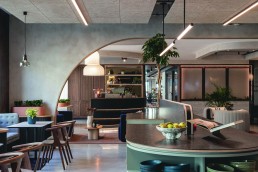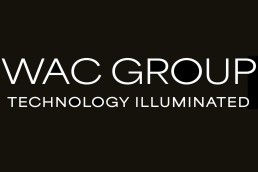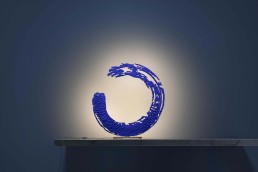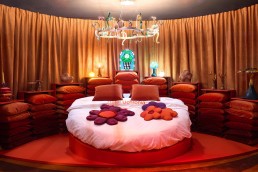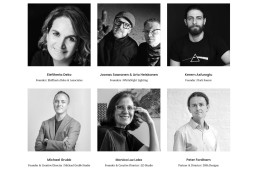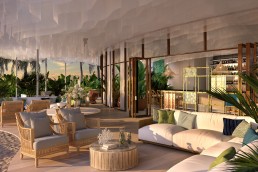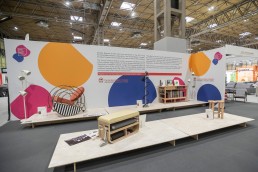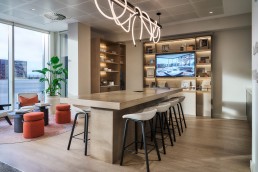Ekho Studio on collaborating with Arup
Ekho Studio collaborated with Arup to create a new, dynamic London-based office for Alexion, which was recently acquired by AstraZeneca.
Pharmaceutical company Alexion, recently acquired by AstraZeneca, has a newly completed 7,000sqft workspace located within AstraZeneca’s existing offices at St Pancras Square, London, UK.
During trade show LiGHT 24 in November last year, [d]arc media’s managing editor Helen Ankers hosted an exclusive Q&A with Sarah Dodsworth, Founding Partner at Ekho Studio, who worked on the project. Dodsworth discussed the project’s journey along with her studio’s collaboration with design and engineering firm, Arup.
Ekho was brought on as lead consultant/lead designer on behalf of the client for RIBA Stages 1 to ascertain and fix the project brief and vision. Following on, it was brought into Arup’s team as the “specialist design services” to join its multi-disciplinary team covering mechanical, electrical, acoustics, environmental and general design management.
“It was of paramount importance to the client that the design solutions were as coordinated as possible, so this model of team structure was adopted,” explains Dodsworth.
The brief for the new design was to enable greater collaboration to drive an innovation agenda, as well as ensuring the new space harmonised with AstraZeneca’s existing offices. These include the 21,000sqft, award-winning commercial head office for AstraZeneca UK, located on the building’s 8th and 9th floors and designed by Ekho Studio in 2021/22, becoming the agency’s first completed project.
Over the next few pages you will find an edited recount of the discussion that took place at LiGHT 24, followed by Dodsworth’s reflections on the completed project, shared exclusively with darc.
Helen Ankers: How did Ekho get involved in the project and what was the initial brief?
Sarah Dodsworth: We’ve been working with this client for a number of years, and this project is an evolution from a scheme that we delivered in 2022 in the same building, which was a relocation of their commercial marketing team from a huge building on the outskirts of Luton into Central London. You can probably imagine, without focusing too much on it, was a huge cultural shift for all manner of reasons - the ways of working, the approach to collaboration with partners being in central London, etc.
This project is on the sixth floor of their new London HQ building, and as mentioned it’s an evolution of where we were with the other scheme. What differs with this design is that it combines workplace for a team that call it home, every day. With a reception concierge, but also significantly, a big conference meeting tech suite. What it offers is a touchdown for the senior execs - who are part of this global company - who travel all over the world, a place to drop in when they land into the UK before moving on again. So, it provides a space with the ability to arrive at any time of the day into an environment that’s appropriate for that, which feels beyond a typical office.
It has the business lounge facilities, the hospitality lay down, catering facilities, and top-notch tech spaces to hold conferences, etc. All of this is combined with what you would call a workplace, with desks, quiet pods, that kind of thing.
Ankers: What struck me when I initially saw the images was how much it felt like a hotel.
Dodsworth: Given the nature of their business, it was important the design wasn’t about frivolity and making things look nice for the sake of it, the absolute fundamentals of it were productivity, ensuring this is a place where wellbeing thrives, and ensuring it’s a functional workplace. And then what ensued around the aesthetics and the look and feel followed. There was no one in that business that would’ve taken us seriously if would’ve honed straight in on textures, colours - which we love doing by the way - but we had to ensure we gained their trust, and they understood what we were doing. For example, the investment into AV and these meeting spaces is so reliant on the lighting: the scene setting, the control element, the glare, the uniformity of light. We had to ensure that we nailed all of that before we started explaining how we can still make this really soft, warm, welcoming. It’s a much softer approach to what an office feels like. Given this is a space where people land in at any given time of the day, it’s not just a nine-to-five workspace, the layering of the lighting, the warmth, but the ability to manipulate and control those spaces from a daytime into an evening use was really important.
Ankers: What challenges did you come across and what were the key focuses?
Dodsworth: I’d say we had opportunities and challenges with this one. I’m sure anyone else involved in interiors, architecture and lighting knows what I mean when I say when you inherit a Cat A spec building - an office building - and there’s already ceilings and lighting in place, the challenges around justifying why we want to remove what’s there, which is new, which is an unsustainable approach, but it’s actually really unconducive for us to be able to create this layered, softer, more nuanced scheme. In some ways it presented an opportunity for us here because this was a previous fit out of a previous occupier that just needed stripping out.
What we were able to do within the office space significantly is define and design something quite tailored and unique that then made the lighting design intrinsic to that rather than, for example, a grid, with a format, with a uniform of light that then no matter how many lovely pendants, layers, and integrated LED fixtures you input, can get lost and not often read because the standard of light is already quite overwhelming.
So, that was an opportunity that we took, there was flexibility. But, conversely to that around the challenges, in the workplace it is all about uniformity of lighting. As much as I’d love to do a little bit more around the contrast between light and shadows, we’re working with engineers and lighting designers, which require uniformity of light in these boardroom spaces and workplaces to ensure that it’s a productive environment. We don’t want people complaining of fatigue or headaches, and the lighting is very much working with that. There’s a beautiful curved blue bespoke bulkhead in the ceiling of the large meeting space, and that caused us real challenges to get the right approach of uniform lighting without a huge proliferation of fittings that just ruined the whole installation’s curved nature. That got the engineers and the technical side ticked but also allowed us to bring in the softer elements as well.
Often, when something looks simple I think you can appreciate that it was hard to achieve to get elements looking beautiful and considered and curated.
Ankers: How was the client to work with - welcoming of new ideas or rigid with the brief?
Dodsworth: I think that is the benefit of working with a client before, isn’t it? You’ve bought some trust, and we delivered quite a groundbreaking scheme for them a few years ago, which was a game changer for them. I think we had the opportunity there because the marketing team were a slight subsidiary of the global team, and they wanted to purposefully mix things up and do things differently. They wanted spaces that felt more hospitality focussed.
So, when we latterly do these spaces, which are very much for a corporate audience, we’ve at least got some great benchmarks, we’ve already brought them on that journey. Needless to say, there are the standards that are written within the corporate literature around the CIBSE guidance and the lux levels being 500, etc. So, we very much have to work collaboratively with the entire design team to ensure that we’re illustrating that this works functionally, fundamentally, but equally we’re not just there to nod along and tick the boxes, but to push the agenda as well and explain how the workplace has changed, as we all know, believe us there’s another way. We can get these spaces to be functional but also make them beautiful so that people genuinely want to come to work as well.
It’s about dialogue and it’s about throwing yourself into those technical workshops as well as it is then relaying that back to the client where some of the technicalities are lost but ensuring them that you’re ticking every box as it were.
Ankers: You mentioned working collaboratively with other designers on the project; do you have a lighting design team, or did you work with another studio on any lighting design for this project?
Dodsworth: At Ekho Studio, we’re all interior designers. We are massively passionate about lighting design because if you haven’t got good lighting, no matter what we do, you will only achieve so much. Even though we like to think we’re fairly well-educated, we would always collaborate. On some projects it’s a given that the design team doesn’t just have an electrical consultant, it involves lighting specialism. It isn’t always a given, so we are massive advocates - I sometimes think I should be on commission with the number of times I try to get feature lighting consultancy in on a project! As much as we have the vision and we know what we want to achieve, we fundamentally could not do that solo; we very much work as a team and rely on coming together to discuss how we achieve things and how we can do it across all the different parameters that we need to do.
Ankers: Where do you think an interior designer’s job ends and a lighting designer’s starts?
Dodsworth: I can only speak from our experiences. Our studio sees a project through to completion following the RIBA stages all the way through to RIBA six. So, to me it doesn’t end, but obviously you have different involvements at different stages depending on how technical the stage is. You’re selling the dream, interpreting the brief at RIBA one and two, and then bringing in lighting design hopefully never later than RIBA stage three; now we need the help. We’ve sold the concept and everyone’s on board, but we really need [the lighting designers] to help us work this out.
Ankers: What were the standout features for you in terms of the lighting?
Dodsworth: They probably look very simple but I am incredibly proud of the timber rafts that we created for the office space, because when you walk in, the tone is just set. Generally, we are used to a more gridded version of ceilings, unless you have some cool warehouse or ex-industrial building. This is an a-typical office building. The fact that we could get the client on board to invest, because it is quite a bespoke, tailored solution, we wanted the natural materials and tones to create the whole story of sustainability around the choice of materiality and that connection to nature. But I think what’s really important to how we approach the lighting within the workspace, and again, this comes back to this layered lighting, was that it wasn’t just strips of LEDs throughout. Yes, we had to ensure for the uniformity, but there’s lots of downlights that provide softer pooling of light in conjunction with something more functional. And then where we’ve got some of the suspended pendants within the collaboration zones, for me it’s really important to ensure that lighting’s not just coming down, it’s actually indirect as well.
I can’t help but feel that sometimes when you go to Scandinavia particularly, they’re really good at getting the light to be indirect as well as direct and bounce off the surfaces, which creates for a softer environment. I am a migraine sufferer and too much of bright lighting really triggers me. So, I think it’s just about how people feel comfortable in the space, but then ensuring that it is productive throughout all these hours of operation.
I’m also really proud of the bespoke curved blue ceiling installation that we developed, which comes off some of the original concepts around form that we wanted to do. Curves have this sort of subliminal, relaxing and softening feel to them. How do we take a very corporate client and create a sophisticated and calm space that can’t be too homely, because that would have been frowned upon - it’s sophisticated and grown up and professional. That particular ceiling was a real challenge. So, we formed this bespoke bulkhead, and the blue colour, which has a mottled texture, is formed from a natural clay product. This gives a real striking effect within the space and allows the light to bounce off something with some aggregate and texture to it. Set within that is acoustic panelling, which had to be bespoke formed to fit in our shapes and finished with beautiful handblown glass pendants dropping down. Lots of design workshops went into this feature, and it was very much about bringing everybody on board collaboratively.
Overall, there are loads of lovely details throughout, lots of nice pendants, table lamps and integrated LEDs, which are all fabulous, but were a little more straightforward to deliver. It’s always the things that are a challenge that particularly stand out in your head.”
Reflecting on the project as a whole, Dodsworth elaborates to darc the working relationship Ekho Studio had with Arup. “This was our first time working with Arup. We learned an appreciation of the technical aspect of a fitting, so much more than what it looks like. For example, the output of a light per unit being a determining factor, which influences quantity and spacing, not least linked to the energy efficiencies too.
“The client team’s priority was always function over form and to generate spaces for high productivity. Our challenge as a project team was to find solutions that meant we delivered on functionality with a considered design approach.
“The architectural lighting elements were intrinsic to ensuring spaces are appropriately lit to suit the usage of each environment, while the decorative elements created warmth and softness, which resulted in a layered approach. This gave the scheme it’s unique edge and aesthetic and also meant that the work settings are very adaptable.”
WAC Lighting Launches WAC Group
(USA) – WAC Lighting has announced the launch of the WAC Group, a new collective for its distinctive lighting and smart fans brands. The group combines cutting-edge technology, exceptional design, and a commitment to customer success under the tagline “Technology Illuminated.”
The new parent brand brings together WAC Lighting, Modern Forms, Schonbek, AiSPIRE, WAC Limited, and WAC Landscape Lighting under one umbrella, creating a one-stop destination for lighting and fan solutions in residential and commercial spaces.
The unified portfolio provides lighting showrooms, homeowners, architects, interior designers, lighting designers, landscapers, integrators, and other professionals with a range of products spanning various styles, price points, and advanced lighting and fan technologies.
“WAC Group combines our heritage of design with the latest technology,” says Becki Li, President of WAC Lighting. “By bringing our brands together, we’re enhancing our ability to provide innovative solutions that not only illuminate spaces but improve how people use light – making environments smarter and more energy-efficient.”
Jenifer Walsh, Chief Marketing Officer, adds: “We’re creating a future where lighting is more than just lighting. It’s lighting technology that is more intuitive, efficient, and inspiring than ever before. By unifying our portfolio of brands, we’re setting new industry standards in function and design and delivering this broad range of innovative solutions to our customers.”
The WAC Group will maintain its individual brands’ names, websites, and teams while offering a streamlined approach to servicing lighting professionals and end users.
The Relationship between Interior Design and Architectural Lighting
https://vimeo.com/1034344713
Lighting is the secret to a successful interior. Interior Designer Jo Calver of Isla James Interiors will take a closer look at lighting’s relationship with fabrics and colours in the home, feature lighting, colour temperature, the power of light and shade, and how layering your lighting can add to the complexity of your design.
Catellani & Smith - Ensō lamp
(Italy) – Italian decorative lighting brand wins accolade for its Ensō lamp from the China Athenaeum: Museum of Architecture and Design.
The lamp, inspired by Japanese calligraphy, blends art and innovation and showcases the brand’s signature mix of craftsmanship and cutting-edge design.
The Ensō lamp features a hand-painted blue structure that mimics the fading ink of an unfinished circle, resting on a brass base. Standing at 66cm tall, it uses a patented wireless LED system to create a soft glow on walls, combining functionality with sculptural art.
This win highlights Catellani & Smith’s commitment to creating timeless, artistic lighting pieces that redefine spaces.
Maison&Objet: What’s New? In Hospitality
(France) – Maison&Objet wrapped its 2025 edition, which presented an insight into future trends and products for the hospitality industry.
“At Maison&Objet, we see hospitality as a key element of our differentiation strategy. The industry’s professionals are looking for unique, striking pieces that go beyond the functional solutions available elsewhere. They come to us for inspiration and to discover creations that will make their projects stand out. This is why we have created dedicated areas, such as the ‘What's New? In Hospitality’ spaces, where we have chosen to work with Julien Sebban, a rising star in the design world. His original and disruptive vision of hospitality, illustrated through bold staging that incorporates a selection of carefully curated products, perfectly meets the specific needs of hotel and restaurant professionals,” says Mélanie Leroy, Managing Director of SAFI (Maison&Objet, ParisDesign Week, MOM).
Sebban was given carte blanche to design the What’s New? In Hospitality by Uchronia space, which aimed to take a fresh look at – and for – the hospitality sector. In the centre of Hall 6, the architect and designer imagined the Hotel Uchronia, a surreal immersion in a unique hotel. Sebban plunged visitors into the world of the weird and wonderful in a 200sqm space that paid tribute to surrealism embodied in a concept hotel.
Divided into three main areas, each zone offered an immersive, offbeat experience, blending art and function in a setting that defied convention. A Café-Bar where day and night are reversed, and the rules of scale and proportion are turned upside down. A Master Bedroom, part-dream, part-metamorphosis, transported us into a room where dreams took over from reality. And finally, a gym and a garden, embodying a fantasy in motion, where energy and poetry came together in a space dedicated to sport and nature.
To find out more about market trends, What's New? In Decor in hall 7 presented a selection of new products from exhibitors. Elizabeth Leriche invited visitors to discover the colours and materials that will shape the interiors of tomorrow.
Within a large labyrinth marked out on the floor to symbolise the unconscious, she created an immersive, dreamlike journey that disconnected visitors from reality and sought to fill them with wonder. In a cabinet and salon of curiosities, a bedroom of dreams that underlines the importance of the imagination, played on scale and proportion, and a hypnotic corridor, we discover a selection of styles and new products, offering a veritable compass to guide interior designers, buyers and creators in their choices.

Elsewhere, throughout the show floor, exhibitors were separated into sections for hoteliers and restaurateurs to discover brands. Sections included: Signature, Today, Forever, Unique&Eclectic, Craft, and Projects. Each presented innovative furniture and lighting solutions tailored to the technical and stylistic requirements of hotels, restaurants and third-party venues.
Also presented at the fair was the Rising Talent Awards - Korea. Following the trend of ‘hallyu,’ Korea’s cultural ‘soft power,’ the peninsula has become home to many established international architects who work in this highly inspiring setting. The new generation of designers explored the paradoxes between Western influences and the roots of their craft heritage, innovating with ancestral materials and shifting the boundaries between design and art - or vice versa.
For the 2025 edition of the Rising Talents Awards, Maison&Objet pointed its compass rose towards this hotbed of creative activity. Dereen O’Sullivan, head of the Rising Talents Awards programme, explains: “The languages they weave are marked by an assertive futurism, refined originality and a reinvention of sculptural techniques. Moreover, our daily lives are fuelled by this giant of industrial and technological innovation. Finally, even if the Korean creative scene is recognised today, we still have much to discover.”

As usual for the awards, all recipients are under 35 and have set up their studio less than five years ago. Together, they represent an aesthetic that is both modern and respectful of the rich history of the dynasties that once ruled the shores of the Yellow Sea.
One of the winning designers to present decorative lighting is Minjae Kim, a 34-year-old Korean artist based in New York, who designs furniture that acts as an antithesis to architectural practice (he has a degree in architecture) in terms of time, scale and accessibility. His creations in quilted fibreglass, bamboo and wood are like short sentences revolving around an idea. It might be a chair made of translucent leaves, or a lamp balanced by wooden weights. One of these lights up when two brass rods touch.
Maison&Objet returns to Paris 4-8 September 2025.
[d]arc awards judges announced
(Worldwide) – The judging panel for this year’s [d]arc awards has been revealed, featuring past winners of the coveted Best of the Best title.
These industry leaders earned the honour by entering their projects or products which then received the most votes across all [d]arc awards categories.
The panel includes:
- Eleftheria Deko, founder of Eleftheria Deko & Associates
- Joonas and Arto Heiskanen, founders of WhiteNight Lighting
- Kerem Asuroglu, founder of Dark Source
- Michael Grubb, founder and creative director of Michael Grubb Studio
- Monica Luz Lobo, founder and creative director of LD Studio
- Peter Fordham, partner and director of DHA Designs
Submissions for this year’s awards close on 24 January, after which these experts will shortlist entries for the industry’s only peer-to-peer voting system. Designers will decide the winners, who will be revealed on 25 April at the [d]arc awards party in London.
Now in its 10th year, the [d]arc awards plans to make this a night to remember to celebrate this landmark anniversary – this will not be one to miss!
There are just four days left to enter, visit www.darcawards.com/enter to submit your projects, products and events. You’ve got to be in it, to win it.
Ennismore announces key 2025 openings
(Worldwide) – Lifestyle and leisure hospitality company Ennismore, has unveiled major openings for this year, marking a significant year of global growth with expansion into new markets and brand debuts.
Ennismore will enter several markets for the first time, including Australia with three brands – Hyde, Mondrian, and 25hours, as well as Ireland with The Hoxton Dublin and brand debuts with SLS Europe and Mama Shelter in Asia.
The company is also advancing its standalone restaurant and bar offerings through partnerships with Rikas Group and Paris Society, alongside its in-hotel concepts by Carte Blanched. These ventures aim bring culturally relevant experiences to local communities.
Gaurav Bhushan, co-CEO of Ennismore, says: “Following a remarkable year of openings in 2024, highlighted by the groundbreaking debut of the Delano Dubai, we eagerly anticipate another bold year of hotel and restaurant openings across all regions. This year marks several significant milestones for Ennismore and our brands, including heading to Australia for the first time, the grand opening of the first-ever SLS all-inclusive, the return of the iconic Delano Miami and the hotly anticipated arrival of Rikas brands in Europe and the Americas. We are incredibly excited to bring our unique experiences to new destinations and guests worldwide.”
Highlights of 2025 Hotel Openings
Asia Pacific
- Mondrian Gold Coast, Australia: Blending luxury coastal hospitality with eclectic design, this property will offer studios, suites, beach houses, and vibrant F&B options. (mid-2025)
- Hyde Perth, Australia: A bohemian-inspired retreat featuring lush outdoor spaces and a specialty café (mid-2025)
- 25hours Hotel Sydney The Olympia: Celebrating cinematic history with over 100 art-filled rooms, themed suites, and a rooftop bar (mid-2025)
- Mama Shelter Singapore Orchard: The brand’s Asia debut includes a rooftop pool and urban oasis design (mid-2025)
Americas
- SLS Playa Mujeres, Cancún: SLS’s first all-inclusive resort combines style, dining, and entertainment (January 2025)
- Delano Miami Beach: Returning with revamped spaces and a beachfront deck (late 2025)
Europe
- SLS Barcelona, Spain: A Mediterranean-inspired escape with six F&B outlets and luxury amenities (early 2025)
- The Hoxton, Dublin: A restoration of the Central Hotel featuring a music venue, café, and Library Bar
- Mama Shelte Zürich: Stylishly located in the vibrant Oerlikon district (mid-2025)
Middle East & India
- Rixos Montaza Alexandria, Egypt: Luxury meets history (January 2025)
- Mondrian Abu Dhabi, UAE: six dining venues and lagoon views (late 2025)
F&B Highlights
Ennismore’s culinary ventures expand in 2025 with standout concepts:
- Twiggy by La Cantine Playa Mujeres: A Mediterranean-inspired beach club in Cancún.
- Fi’lia: Authentic Italian dining debuting in Abu Dhabi and the Red Sea.
- Cantina Valentine: A Peruvian culinary journey launching in Dublin.
The Importance of Decorative Lighting in a F & B Environment
https://vimeo.com/1034343628
Decorative lighting is the soul of a space, without it the environment can feel lifeless and uninspired. Wing Shum, Senior Interior Designer at AB Concept, discusses the importance of decorative lighting in a F&B environment, highlighting the considerations to the architecture and referencing recent project case studies.
Enter the [d]arc awards now!
(Worldwide) – Designers have until 24 January to enter their project lighting schemes and decorative lighting products to be in with a chance of winning the prestigious [d]arc award accolade.
Organised in collaboration with Light Collective, the [d]arc awards utilise the worldwide reputation of arc and darc magazines and offers a unique opportunity to showcase your work to the global design community.
Anyone can enter, including lighting designers, architects, interior designers, or manufacturers. Once the shortlist has been chosen by an international jury, independent lighting designers, architects, interior designers, and product designers can vote on their favourite projects and products, making this the only peer-to-peer lighting design awards in the world.
The decorative categories include Place High budget or Low budget (best interior lighting scheme), Kit Decorative (best decorative product), and Bespoke (best unique decorative lighting installation). Those who make it through the voting stage (and you must vote in each category) will be invited to attend the exclusive [d]arc night party in London on the 25th of April - an event that has created a reputation as one of the must-attend events of the year for lighting, where the winners shall be announced.
All submissions are published on the website and entrants also benefit from a free [d]arc awards directory company profile – a comprehensive online lighting design resource that can be used by designers and clients for inspiration.]
Submissions must be entered on or before the 24 January. Please head to www. darcawards.com/enter-the-awards to find out more.
JFS Partners with The Furniture Makers’ Company championing emerging talent
(UK) - The January Furniture Show (JFS) announces its continued partnership with The Furniture Makers’ Company for 2025, focusing on fostering young talent and innovation within the furniture industry.
A highlight of the collaboration will be the Young Furniture Makers Showcase, hosted at the BFA Networking Hub in Hall 5. This platform will feature pieces from students and graduates who participated in the 2024 Young Furniture Makers exhibition, offering them invaluable exposure to industry leaders.
Brian Ahern, Master of The Furniture Makers’ Company, comments: “This partnership advances our mission to support the welfare and development of the furnishing industry. We’re thrilled to showcase the incredible talent of young designers at such a prestigious event.”
Zoë Bonser, Portfolio Director of JFS, adds: “We are delighted to partner once again with The Furniture Makers’ Company. The Young Furniture Makers Showcase is a key part of our event, providing a platform for emerging talent to gain recognition and connect with industry leaders. Supporting young innovators is crucial to the future of the furniture industry, and we’re proud to play a role in championing their creativity and ambition.”
The partnership underscores the shared commitment of both organisations to sustaining a thriving British furnishing sector by championing the next generation of designers and makers.
Ayers Saint Gross names Joel Fidlar as next president
(USA) - Award-winning design firm announces Joel Fidler, AIA, LEED AP BD+C, as its next president, effective January 1, 2025.
Fidler, a Principal and Vice President with over 25 years of architectural experience, will succeed Luanne Greene, FAIA, who has served as president since 2016. Since joining the firm in 2011, Fidler has led transformative projects, including the Duke University Centre for Interprofessional Education and Care, Clark University's Centre for Media Arts and Computing Design, and the Missouri Botanical Garden's Jack C. Taylor Visitor Centre.
“I continue to be inspired by the work of Ayers Saint Gross, and I am honoured to be leading such a talented group of individuals,” says Fidler. “Our firm is a collection of creative thought leaders with a passion for tackling the increasingly complex challenges of our world, from climate change to the socio-economic impacts of urban growth. As President I look forward to identifying innovative ways to leverage our entrepreneurial mindset and expertise in even more impactful ways. Together, we will continue to create beautiful, resilient spaces that bring people together.”
Under Greene’s leadership, Ayers Saint Gross emphasised design excellence and sustainability, shaping the firm’s mission-driven ethos. Greene will remain in a leadership role, providing strategic guidance as the firm enters its next chapter.
Greene adds: “Joel is the perfect person to carry on Ayers Saint Gross’s over 100-year legacy of excellence while also keeping our focus on the future. His thoughtful, team-driven approach and dedication to serving our clients and our communities, makes him the ideal choice to steward us into this new era. Our work is about more than just design; it’s about solving complex problems and creating environments that inspire, and I can’t wait to see what Joel will accomplish.”
OCCA Design Relocates to New Glasgow Studio
(Scotland) – Scottish interior design studio has unveiled its new headquarters in central Glasgow, a custom-designed studio that embodies the company’s values and design expertise.
Bathed in natural light, the immersive space fosters collaboration among OCCA's interior design, procurement, and branding specialists, while serving as an inspiring showcase for clients.
Designed by the OCCA team, the studio features a carefully curated mix of premium materials and products, many locally sourced to reflect a strong sense of place. Equipped with ergonomic workstations, a design library, private meeting rooms, and sculptural lighting installations.
“This is more than just a workspace – it’s a creative hub crafted with our signature attention to detail,” says Kate Mooney, Founder and Principal of OCCA. “It’s a place where our team can innovate and advance the vision of our clients every day.”

